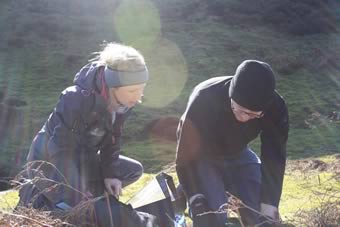Other Surveys:
White-Clawed Crayfish
The white-clawed crayfish is the only native crayfish species in the UK. It can be distinguished from the introduced North American signal crayfish by its smaller size and white-pink underside to its claws. White-clawed crayfish can be found in rivers, canals, streams and lakes beneath cobbles, rocks and debris or within burrows in soft mud. White-clawed crayfish are considered to be a keystone species wherever they occur. Human disturbance and introduction of non-native crayfish has caused a decline in the population of white-clawed crayfish throughout Europe.
White-clawed crayfish are listed under Annexes II and V of the EC Habitats Directive and are protected against taking and sale under Schedule 5 of the Wildlife and Countryside Act (1981). They are also a priority species on the UK Biodiversity Action Plan and a species of Principal Importance in England under Section 41 of the NERC Act 2006. Consequently, local authorities are obliged to consider the protection of the species when determining planning applications. Failure to consider white-clawed crayfish early in the development process can lead to costly delays and set-backs.

BL Ecology Ltd can identify the potential for white-clawed crayfish on site through Extended Phase 1 Habitat Surveys and can provide full white-clawed crayfish presence/absence surveys if potential exists. Once the likely impact of the development is determined, or if white-clawed crayfish are found, mitigation can be undertaken to ensure that crayfish are protected and the development proceeds.
Surveys and mitigation for white-clawed crayfish can be undertaken between July and September inclusive in suitable conditions.
Contact us on 01274 816800 to discuss white-clawed crayfish in your development.
Otter
Otter are large mustelids in the same family as badger, weasel and mink. They are primarily nocturnal and are rarely seen. Otter occur in rivers, streams, lakes, marshland and ditches, occupying territories of up to 40km and resting in holts beneath tree roots and within cavities near to watercourses. The UK population of otter declined dramatically during the 60s and 70s largely due to the use of agricultural pesticides.
Otters and their habitats are protected under European and UK legislation including the Habitats Directive and are a species of Principal Importance in England under Section 41 of the NERC Act 2006. Local authorities are therefore required to protect the species when determining planning applications. Planning permission can be declined if insufficient information regarding otter on the site is held, and the discovery of otter or their signs during works may cause delays to the development.
BL Ecology Ltd can undertake habitat assessments for otter using Extended Phase 1 Habitat Surveys, and can undertake presence/absence surveys if otter potential exists. A mitigation plan can be created, which details how work will be undertaken without causing damage to otters or their holts, or we can assist with an application for a licence from Natural England if damage is unavoidable. It is often possible to avoid damaging otter habitat through identification and protection of key features.
Surveys and mitigation for otter be undertaken at any time of year in suitable conditions.
Contact us on 01274 816800 to discuss otter in your development.
Water Vole
The water vole is the largest vole in the UK, inhabiting rivers, streams, canals and ditches and burrowing within banks alongside watercourses. Water voles feed primarily on reeds and sedges along watercourses, leaving pieces of cut vegetation and droppings as evidence of their presence. The introduction of American Mink at the beginning of the 20th century has driven a large decline in the population of water vole in the UK, exacerbated by the loss of wetland habitat through farming and development.
The water vole and their habitats are protected under the Wildlife and Countryside Act (1981) and is a species of Principal Importance in England under Section 41 of the NERC Act 2006. Therefore local authorities are obliged to ensure protection of the species when determining planning applications. If the planning authority determines that sufficient protection will not be given to water vole during works in a location with water vole potential, planning permission will be refused and the project will be delayed.
BL Ecology Ltd can undertake surveys to establish the potential for water vole on site, and full presence/absence surveys can be undertaken if potential exists. Once the likely impact of the development is assessed, a mitigation plan can be created in order to satisfy the requirements of the planning authority and allow the development to proceed. Often minor adjustments to the development in order avoid potential water vole habitat will sufficiently demonstrate protection of the species. However if translocation is required, it is imperative that surveys commence as soon as possible in order to undertake mitigation at a suitable time of year.
Surveys and mitigation for water vole can be undertaken between March and October inclusive in suitable conditions
Contact us on 01274 816800 to discuss water vole in your development. |